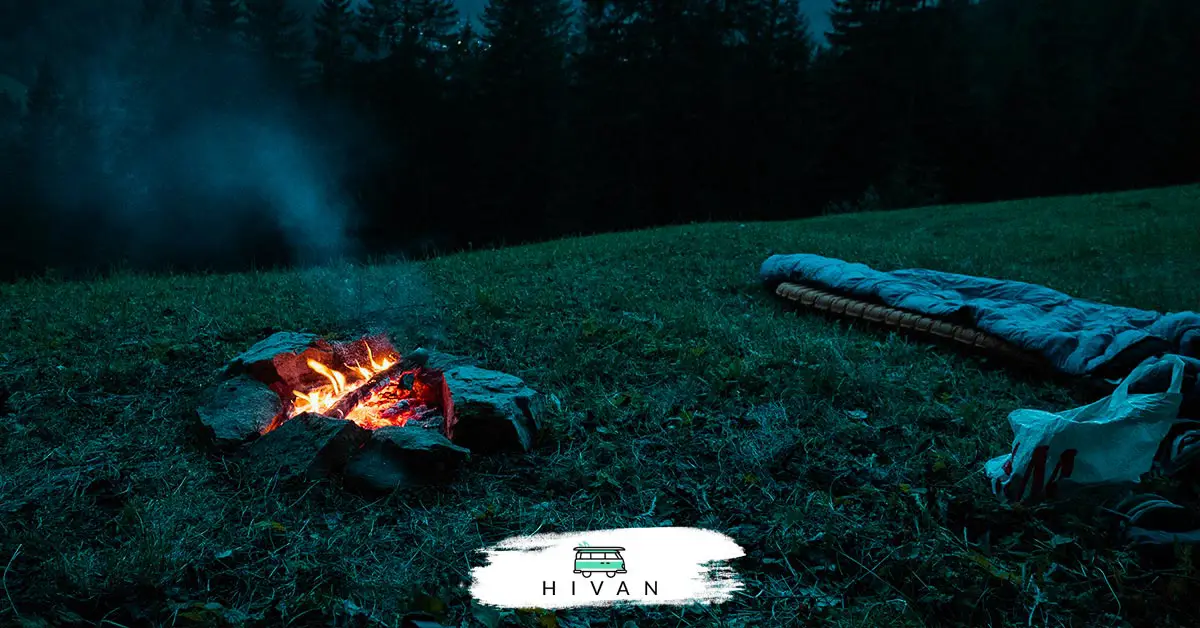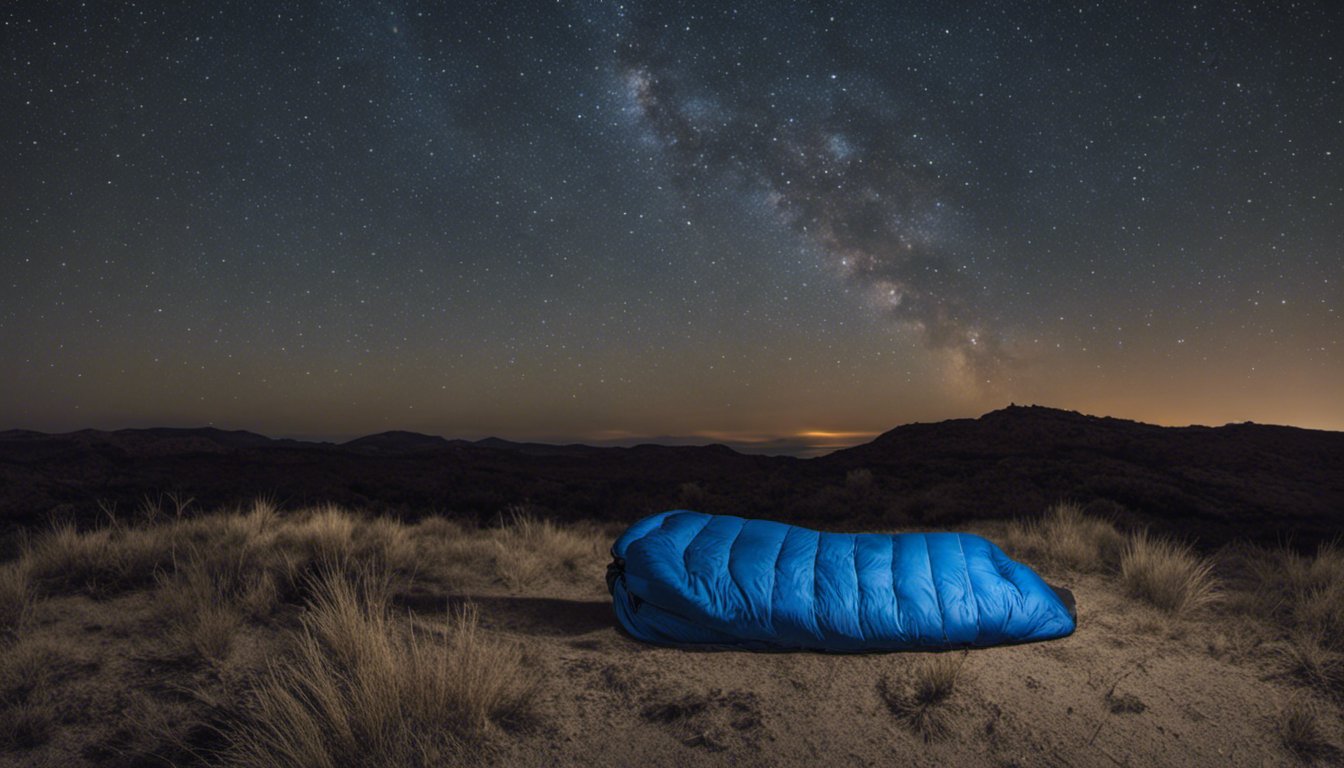Hi-van is supported by its audience. When you purchase using our links, we may earn an affiliate commission (no added cost to you). Learn more
If you’re sleeping outdoors, some natural condensation can be expected, especially if you’re camping out in the cooler seasons. It’s important to know how to keep your sleeping bag warm and dry, both for your own comfort and to avoid hypothermia. But how do you keep the morning dew off your sleeping bag, especially if you’re on the ground?

Here’s how to keep morning condensation off your sleeping bag:
- Cover the sleeping bag with a light tarp.
- Set up your campsite under natural cover.
- Use a synthetic fiber sleeping bag liner.
- Create a bivouac shelter.
- Pack a tent.
- Do not hand-dry the sleeping bag.
Keep reading for information about how to keep your bag dry through the night, as well as some tips on what to do when you wake up to a sleeping bag covered in dew.
Why Sleeping Bag always Collect Condensation?
Sleeping bags can collect condensation due to a combination of external and internal factors. When the air outside is humid and the surface of the sleeping bag is cold, the moisture in the air can condense on the surface of the bag.
Additionally, when you sleep in a sleeping bag, you give off moisture in the form of water vapor, which can also condense on the surface of the bag.
- Bag insulation levels can impact condensation; more insulated bags may have cooler surfaces, leading to more moisture condensing out.
- Moisture from the body can also contribute to condensation inside the bag, so wearing long underwear can help absorb body moisture.
- Using a bivy bag or vapor barrier liner can help manage condensation and keep the sleeping bag dry.
- Adding a plastic tarp over the sleeping bag can reduce condensation, and finding shelter, even under a tree, can also help minimize it.
How to Keep your Sleeping Bag Dry

1. Cover the Sleeping Bag With a Light Tarp
Sometimes a simple solution is all you need to prevent condensation from collecting on your sleeping bag.
According to Outside Magazine, a light tarp can be effective in keeping your bag free from morning dew. If you’re a regular hiker or backpacker, a specialized ENO Eagles Nest Outfitters ProFly Rain Tarp from Amazon.com for rainy weather is a good addition to your packing list.
If you don’t have access to a backpacking tarp, a standard rain tarp can be effective as well.
The advantage of a backpacking tarp, however, is that it can be folded down into a more compact bundle than traditional tarps. Some backpacking tarps are designed to be multifunctional, so that hikers can use them as either a rainfly or a hammock, depending on the conditions.
2. Set Up Your Campsite Under Natural Cover

Outside Magazine also recommends choosing a naturally protected location when setting up your campsite. Sleeping under a canopy of trees can help to reduce the amount of moisture that collects on the outside of your sleeping bag in the morning.
Choosing dry, flat ground is also important when picking out your campsite.
Pitching your camp in a dry, even, and protected place will help to prevent water runoff from entering your camp, as well as limit the amount of condensation.
3. Use a Synthetic Fiber Sleeping Bag Liner
One method of handling morning dew while camping or backpacking is to use a synthetic liner over your sleeping bag. Synthetics dry out faster than down sleeping bags, which makes the morning condensation less of a problem.
Simply shake out the liner in the morning and hang it to air-dry while you break camp or start your day of camping.
The tightly knit plastic fibers that make up synthetic sleeping bag materials are typically more water-resistant than traditional sleeping bags, according to Camping Habits. This means that, while dew may still collect on the outside of the sleeping bag, you will remain warm and dry within.
Stay Warm & Comfy: We designed this sleeping bag liner sheet to provide you with a simple way to stay warm and comfortable even in the outdoors. When used with a sleeping bag, this travel sleeping bag liner can add up to 22°F/ 12°C warmth to your sleeping bag for a good night’s sleep.
On top of keeping moisture out of your sleeping bag, synthetic fiber liners can also help to contain body heat. A synthetic liner, such as a Litume Thermolite All Season Sleeping Bag from Amazon.com, can increase the temperature inside the sleeping bag by as much as 22°F (-5.55°C), according to the product description.
4. Create a Bivouac Shelter
A bivouac, sometimes called a bivy, is a general term encompassing any temporary campsite that doesn’t use tents or shelter. Bivouac shelters are typically minimalist, crudely installed structures intended to be set up and broken down quickly, providing the bare minimum of protection against the elements.
The advantage of bivouacking is that it allows hikers, backpackers, and originally soldiers to carry their shelter with them. The rudimentary nature of bivy shelters means there are fewer pieces of equipment to carry, making it a popular option for grittier long-distance hikers.
Modern Bivy sacks, according to REI, were designed for rock climbers who need lightweight shelter they can carry on their back. If a climber is camping on a rock face during the course of a multiple-day climb, it’s helpful to have a weather-resistant liner.
The difference between a bivouac shelter and a bivouac sack is the former consists of a tarp and lines, while the latter essentially works like a sleeping bag liner.
5. Choose a sleeping bag with better insulation
A well-insulated sleeping bag will help keep the surface of the bag warm and reduce the amount of condensation that forms on it. Here are a few factors to consider:
- Temperature rating: Sleeping bags are often rated based on the lowest temperature they can keep you warm in. Look for a sleeping bag with a temperature rating that matches the conditions you’ll be camping in. For example, if you’ll be camping in cold weather, look for a sleeping bag with a lower temperature rating.
- Fill type: Sleeping bags can be filled with down or synthetic insulation. Down insulation is lightweight and compressible, making it a good choice for backpacking, but it’s not as effective when wet. Synthetic insulation is bulkier and heavier, but it retains warmth better when wet.
- Fill power: If you choose a down-filled sleeping bag, look for one with a high fill power rating. The higher the fill power, the more insulating power the down has, and the warmer the sleeping bag will be.
- Construction: Look for a sleeping bag with good construction, such as a well-designed hood, draft tubes, and a snug fit. These features can help trap warm air inside the sleeping bag and prevent cold air from getting in.
- Brand reputation: Look for sleeping bags from reputable brands that are known for producing high-quality outdoor gear. Read reviews and do your research to ensure you’re getting a well-insulated sleeping bag that will keep you warm and comfortable in a variety of conditions.
By considering these factors, you can choose a well-insulated sleeping bag that will keep you warm and comfortable during your camping trips.
In is Youtube video, Devin discusses his favorite sleeping bags for backpacking and camping trips. He ranks them based on various factors such as comfort, quality, and price.
6. Do Not Hand-Dry the Sleeping Bag
According to Camping Habits, if you wake up with morning dew on your sleeping bag, it’s crucial to dry the bag properly. Wiping water off the sleeping bag may be your first impulse, but that will only serve to soak the water further into the material.
Hang or spread the sleeping bag out in the sun in order to dry. This will allow the water to evaporate out of the bag. Be sure the bag is completely dry before stuffing or packing it away.
Storing even a damp sleeping bag can damage the integrity of the bag and lead to mold, mildew, and foul odors. Always hang your sleeping bag up to air dry after you’ve been sleeping in the open air.
7. Wear appropriate clothing
Wearing long underwear made of wool or other absorbent materials can help absorb moisture and prevent it from condensing on the surface of the sleeping bag.
Final Thoughts
If you’re out on the trails, making sure you have a way to keep warm and dry through the night and morning is crucial. Properly protecting yourself and your sleeping bag from water condensation will not only improve the quality of your camping or backpacking experience but will also extend the lifespan of your sleeping bag.
Covering the sleeping bag with a specialized tarp, bag liner, or bivouac shelter can be beneficial in preventing condensation.
Find this content useful 🙂 ?
Subscribe to our Newsletter and get a free Solar Electric Diagram + shopping list.


